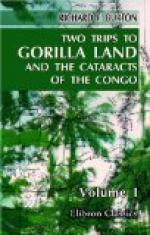The Dikele grammar proves the language, which is most closely allied to the Benga dialect, to be one of the great South African family, variously called Kafir, because first studied amongst these people; Ethiopic (very vague), and Nilotic because its great fluvial basin is the Zambezi, not the Nile. As might be expected amongst isolated races, the tongue, though clearly related to that of the Mpongwe and the Mpangwe, has many salient points of difference; for instance, the liquid “r” is wholly wanting. According to Mr. T. Leighton Wilson, perhaps one word in two is the same, or obviously from the same root; consequently verbal resemblances are by no means striking. The orthography of the two differs materially, and in this respect Dikele more resembles the languages of the eastern coast than its western neighbour, at the same time less than the Fiote or the Congoese. It has a larger number of declensions, and its adjectives and pronouns are more flexible and complicated. On the other hand, it possesses few of the conjugations which form so conspicuous a feature in the tongues of the Lower River, and, reversing the usage of the Mpongwe, it makes very little use of the passive.
Running the gauntlet of cheer and chaff from the noisy inmates of the many Bakele villages, and worried by mangrove-flies, we held our way up the muddy and rapidly narrowing stream, whose avenues of rhizophoras and palms acted as wind-sails; when the breeze failed the sensation was stifling. Lyamba (Cannabis sativa) grew in patches upon the banks, now apparently wild, like that about Lagos and Badagry. Not till evening did the tide serve, enabling us to send our papers for visa on board the guard-ship “L’Oise,” where a party of young Frenchmen were preparing for la chasse. A little higher up stream are two islets, Nenge Mbwendi, so called from its owner, and Nenge Sika, or the Isle of Gold. The Mpongwe all know this name for the precious metal, and the Bakele appear to ignore it: curious to say, it is the Fante and Mandenga word, probably derived from the Arabic Sikkah, which gave rise to the Italian Zecca (mint) and Zecchino. It may have been introduced by the Laptots or Lascar sailors of the Senegal. M. du Chaillu ("Second Expedition,” chap. iii.) mentions “the island Nengue Shika” on the Lower Fernao Vaz River; and Bowdich turns the two into Ompoongu and Soombea. The third is Anenga-nenga, not Ninga-ninga, about one mile long from north to south, and well wooded with bush and palms; here the Gaboon Mission has a neat building on piles. The senior native employe was at Glass Town, and his junior, a youth about nineteen, stood a la Napoleon in the doorway, evidently monarch of all he surveyed. I found there one of the Ndiva, the old tribe of Pongo-land, which by this time has probably died out. We anchored off Wosuku, a village of some fifty houses, forming one main street, disposed north-east— south-west, or nearly at right angles with the river. The entrance was guarded by a sentinel and gun, and the “king,” Imondo, lay right royally on his belly. A fine plantation of bananas divides the settlement, and the background is dense bush, in which they say “Nyare” and deer abound. The Bakele supply sheep and fowls to the Plateau, and their main industry consists in dressing plantain-fibre for thread and nets.




